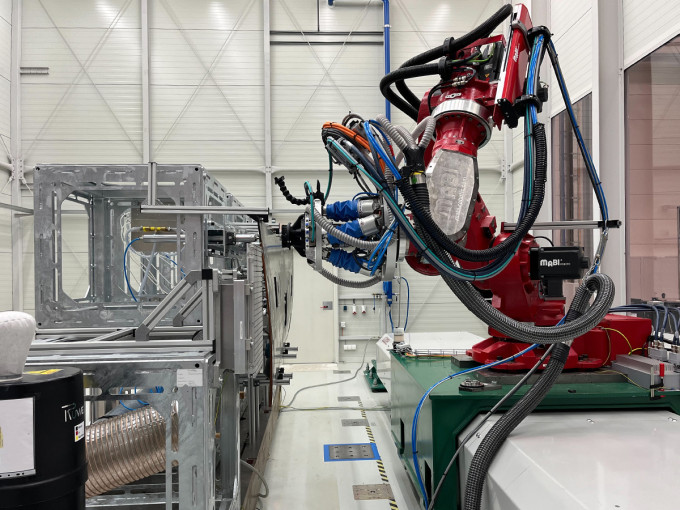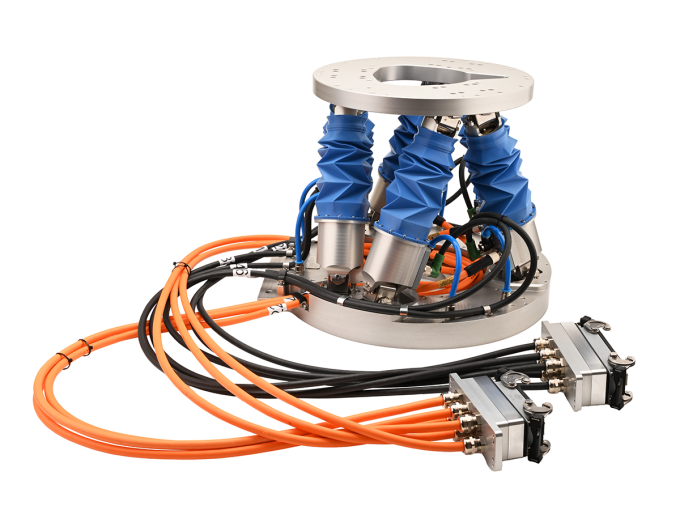Aircraft Construction: Hexapod Enables Highly Dynamic 6-D Compensation Kinematic for Robots
As a partner in the LuFo VI-1: ADMAS (Advanced Machining and Sealing) research project, we presented a new custom-designed hexapod at the International Aerospace Exhibition ILA Berlin in June 2024.
As part of this joint project under the leadership of Airbus, we developed a high-performance 6-DOF hexapod motion and positioning system (model H-900K101) for highly dynamic compensation kinematics in aircraft construction. The project's goal was to enhance the processing and sealing precision of carbon fiber-reinforced composite (CFRP) components in resin transfer molding (RTM) manufacturing processes, while also reducing manufacturing times and process costs.
Dynamic Compensation of Process Forces
The compensation kinematics focus is on the contour machining of the single-aisle wing shells for the Wing of Tomorrow project made of CFRP by means of milling and deburring as well as their subsequent sealing and drilling. Combined with an articulated robot for rough positioning, PI’s hexapod is used for the fine positioning of the machining and sealing tools.
Fine Positioning of Tools
The newly developed hexapod system was designed for the specific boundary and environmental conditions of the application and is therefore particularly optimized for the time-critical manufacturing processes with the tight tolerances required by the aerospace industry.
In addition to this high dynamic performance, the hexapod system offers fiber optic data transmission between the hexapod controller and the driver electronics. The system is also characterized by a very low latency time when used with an EtherCAT® interface and components sealed in accordance with protection class IP54. For the EtherCAT® interface, a deep integration of the EtherCAT® functionality into PI’s controller and driver architecture has been realized.
Condition Monitoring
The LuFo VI-1: ADMAS project also investigated the use of acceleration sensors for wear detection on individual hexapod struts in the context of condition monitoring. The frequency spectrum of vibrations within a single strut can be mapped to characteristic eigenfrequencies of drive components, providing an indicator of system changes.
Under the leadership of Airbus, we have contributed our more than thirty years of expertise in hexapod development to this research project. The project, which was publicly funded by the German Federal Ministry for Economic Affairs and Climate Protection and supervised by the DLR Project Management Agency for Aviation Research, was successfully completed at the end of April 2024.
The development at PI was led by Dr. Christian Sander, Head of Technology Development Parallel Kinematics, and was supervised by David Morof, Technology Engineer / Technology Development Parallel Kinematics, as system engineer. In addition, many of our experts contributed to the success of the project, including Matthias Dörr and Paul Müller (project management), Siegmar Klein (system engineer at the start of the project), Christian Muellerleile (firmware and electronics development and commissioning), Thomas Stumpf and colleagues from the prototyping department (hexapod assembly), Philipp Argus (PID tuning, dynamic tests, condition monitoring), Matthias Schulz (driver and controller setup, cabling), Thomas Kropaci and Yannik Dosch (EtherCAT programming and digital interface), Michael Schröder, Sebastian Riegel and other colleagues from the value stream (processing).
With the new H-900K101 hexapod, we have implemented a highly dynamic system that can accelerate a payload of up to 40 kg in the XY plane at up to 12,000 mm/s². The system is able to dynamically compensate for high-frequency path deviations under the influence of process forces during milling.
Contact person: Dr. Christian Sander, Head of Technology Development Parallel Kinematics

